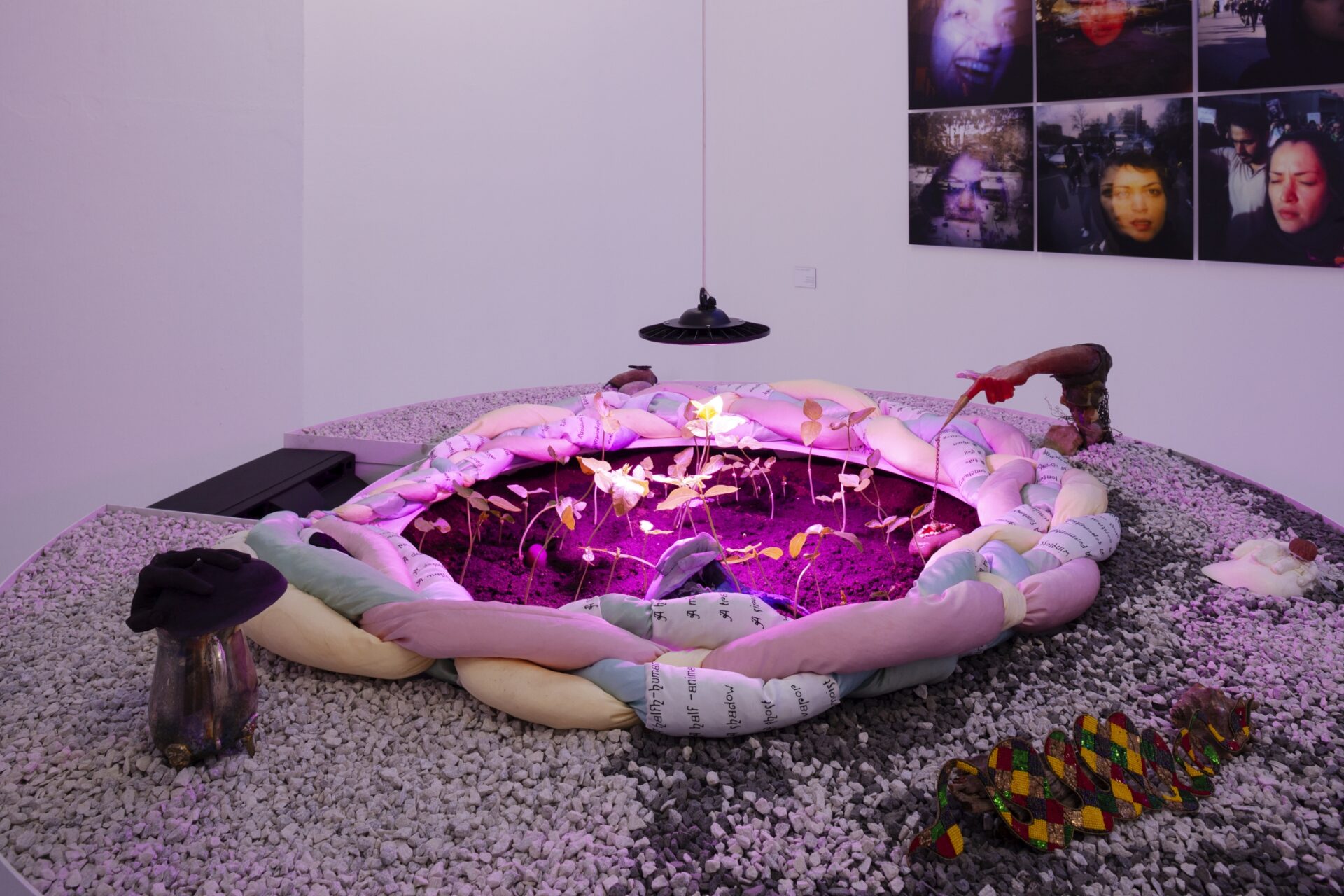
Chupan Mehraneh Atashi, installation shot at EKKM, photo: Paul Kuimet and EKKM
Seeds as memory capsules – Chupan Mehraneh Atashi’s political acts of remembering
Confronted with the mechanics of control and censorship in their home country of Iran, Chupan Mehraneh Atashi started searching for other ways of portraying themselves. Captivated by their self-portraits and pictures of flowers, Katayoon Barzegar follows the artist as they install their exhibition at EKKM in Estonia, and traces the fruitful symbols of seeds and flowers in their work, sketching a portrait of an who continuously cultivates different ways of re-interpreting the self.
This text emerged from a profound an ongoing conversation between Chupan Mehraneh Atashi and myself, in their studio in Amsterdam in September 2023. The dialogue continued afterwards, beyond the physical space and online, as the artist installed their work at the Contemporary Art Museum of Estonia (EKKM). Throughout this ongoing exchange, we shared pictures and voices, and engaged in discussions spanning the realms of the past, present, and future, encapsulated within artworks that bear a rich history of resistance.
Chupan Mehraneh Atashi (1980, Tehran) is a visual artist based in Amsterdam and Washington, DC, whose practice encompasses sculpture, drawing, animation, photography, writing, sound, performance, and installation. Throughout their various projects, Atashi consistently returns to specific materials, manifesting them in different configurations. Most recently, Atashi presents a series of works in the group exhibition titled Laugh of Medusa at EKKM, curated by Maria Helen Känd, on view from October 27th to December 17th, 2023. The constellation that Atashi has crafted in this current exhibition blends previous works with new ones, forming what could be considered a mid-career showcase, with works spanning from 2008 to 2023. All series within the exhibition are deeply intertwined with the artist’s life experiences and speak to Atashi’s approach to art as an ongoing project devoid of linearity and a fixed endpoint.
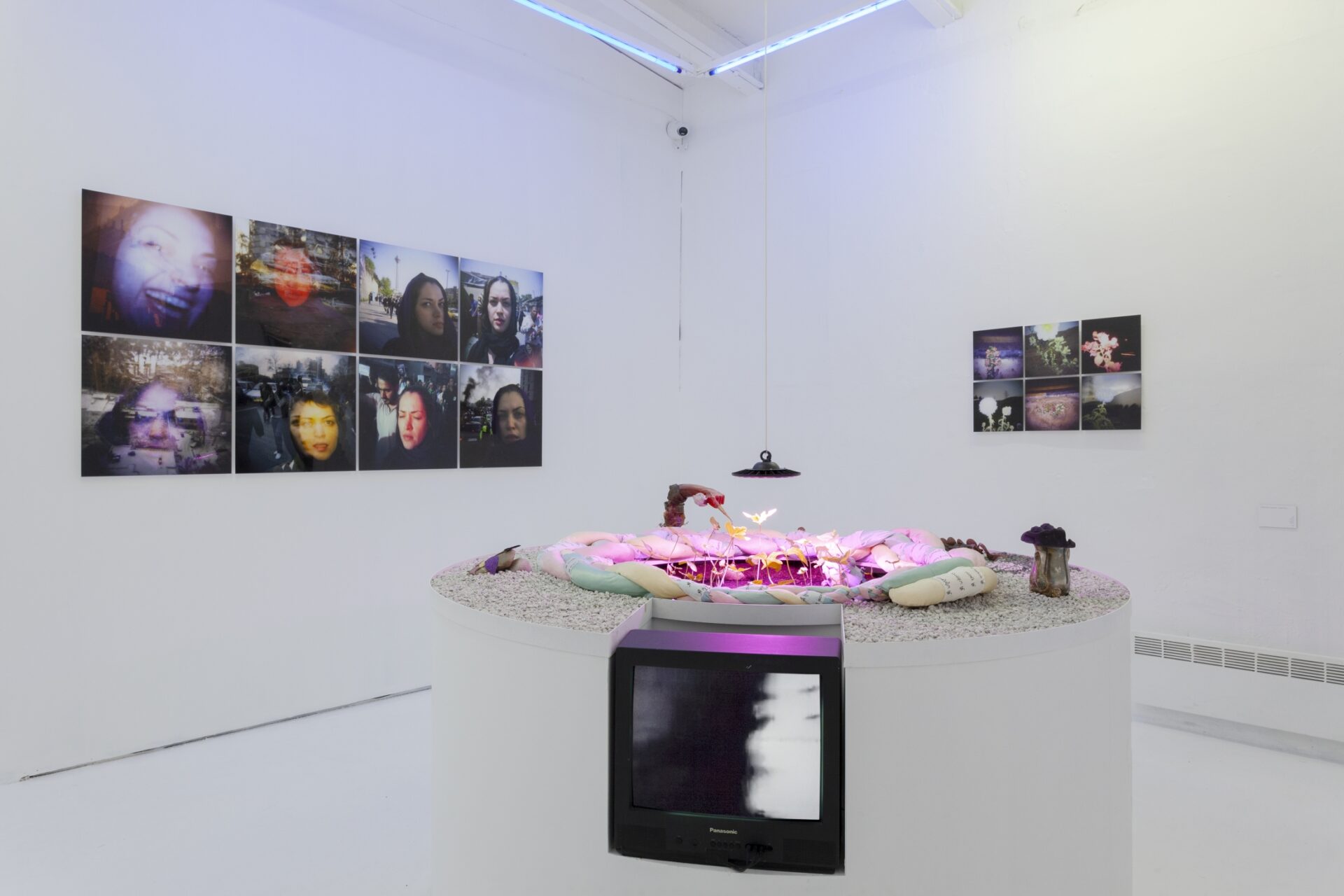
Chupan Mehraneh Atashi, installation shot at EKKM, photo: Paul Kuimet and EKKM
Threats to the self
Atashi’s earliest series included in the exhibition, Tehran Self Portraits, was created during two years of walking and traversing the streets of Tehran from 2008 to 2010. The project coincided with the so-called Green Movement, a wave of protests that spanned several months, drawing in millions of protesters claiming their rights in the streets. In the photographs of this series, Atashi depicts themselves, fractured by the power dynamics of a context marked by oppressive mechanisms of control and censorship. Emerging in flashes across the urban landscapes of Tehran, this evolving self morphs in relation to − and at times in alienation from − the shifting contexts of public uprising. The evolution of the portrayal of the self can be traced from Atashi’s early works in Iran to their more recent installations, which the artist created after their migration.
The Green Movement marked a crucial moment in Iran, being the first image-based movement of its kind, due to the widespread use of smartphones and the internet. These technologies made it possible to capture and swiftly circulate images showing the unfolding realities on the streets. This development posed a significant challenge to government censorship, prompting authorities to become exceedingly sensitive to the act of taking photographs. Understanding the dynamics of these conditions is essential to comprehending the position and agency of Atashi during these historic moments. In this particular case, imagine a woman with a camera navigating a gendered space, striving to infuse her identity and gender into the broader social movement occurring within society.[1] She instantly becomes a contested figure in the midst of the crowd, her face illuminated by the flash of her camera. In this series, it is the woman who assumes the central role, highlighting the artist’s agency in preserving these moments. However, her imposition in the foreground also alters the historicity of the moment, as national, personal, and political narratives clash together. Atashi enfolds these complexities into the action of the self-portrait in protest. This act came with consequences, including imprisonment and threats, which eventually compelled the artist to secure her remaining archive and depart the country in uncertainty about the possibility of returning.[2] This displacement naturally left its mark on Atashi’s practice and the representation of the self within it.
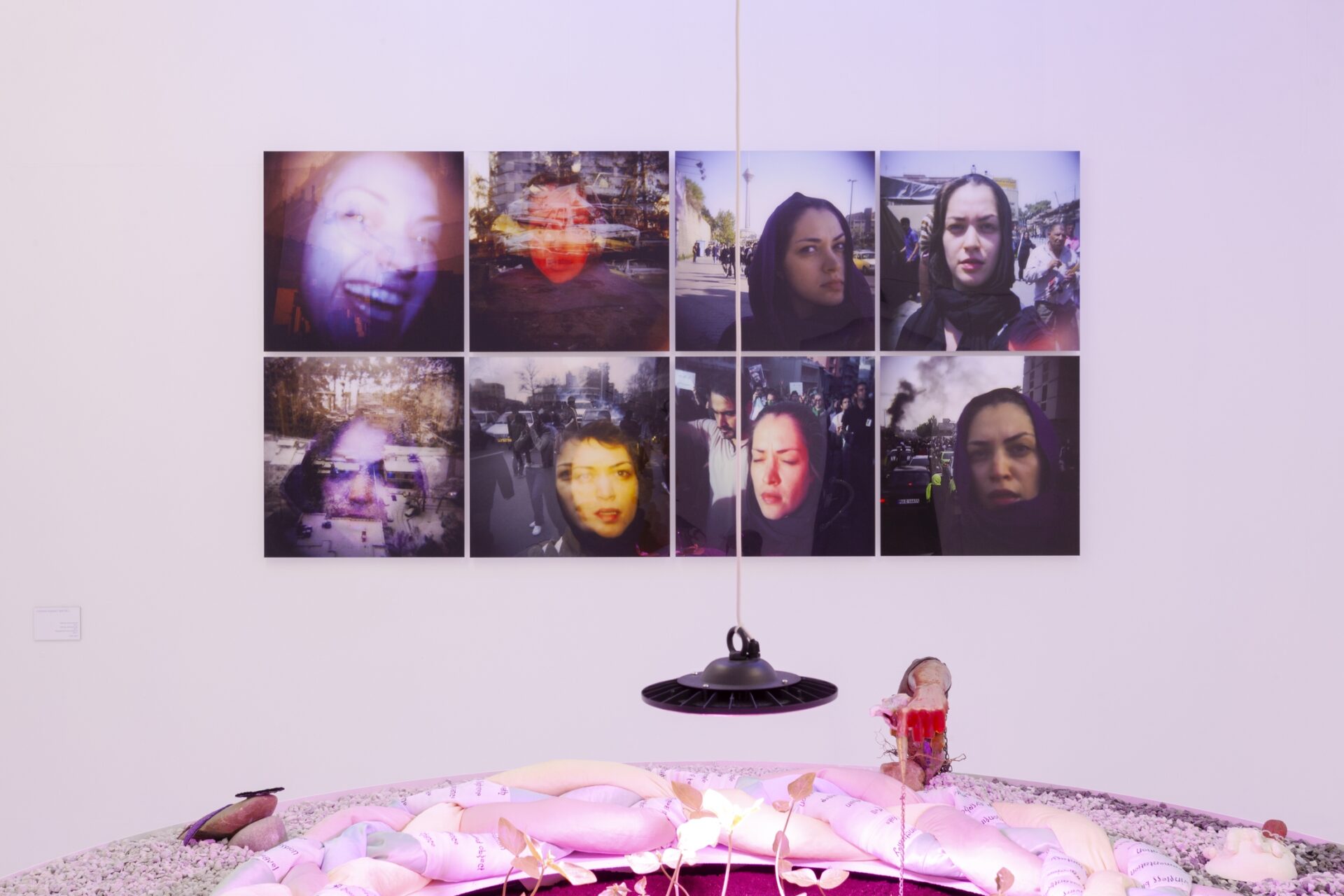
Chupan Mehraneh Atashi, installation shot at EKKM, photo: Paul Kuimet and EKKM
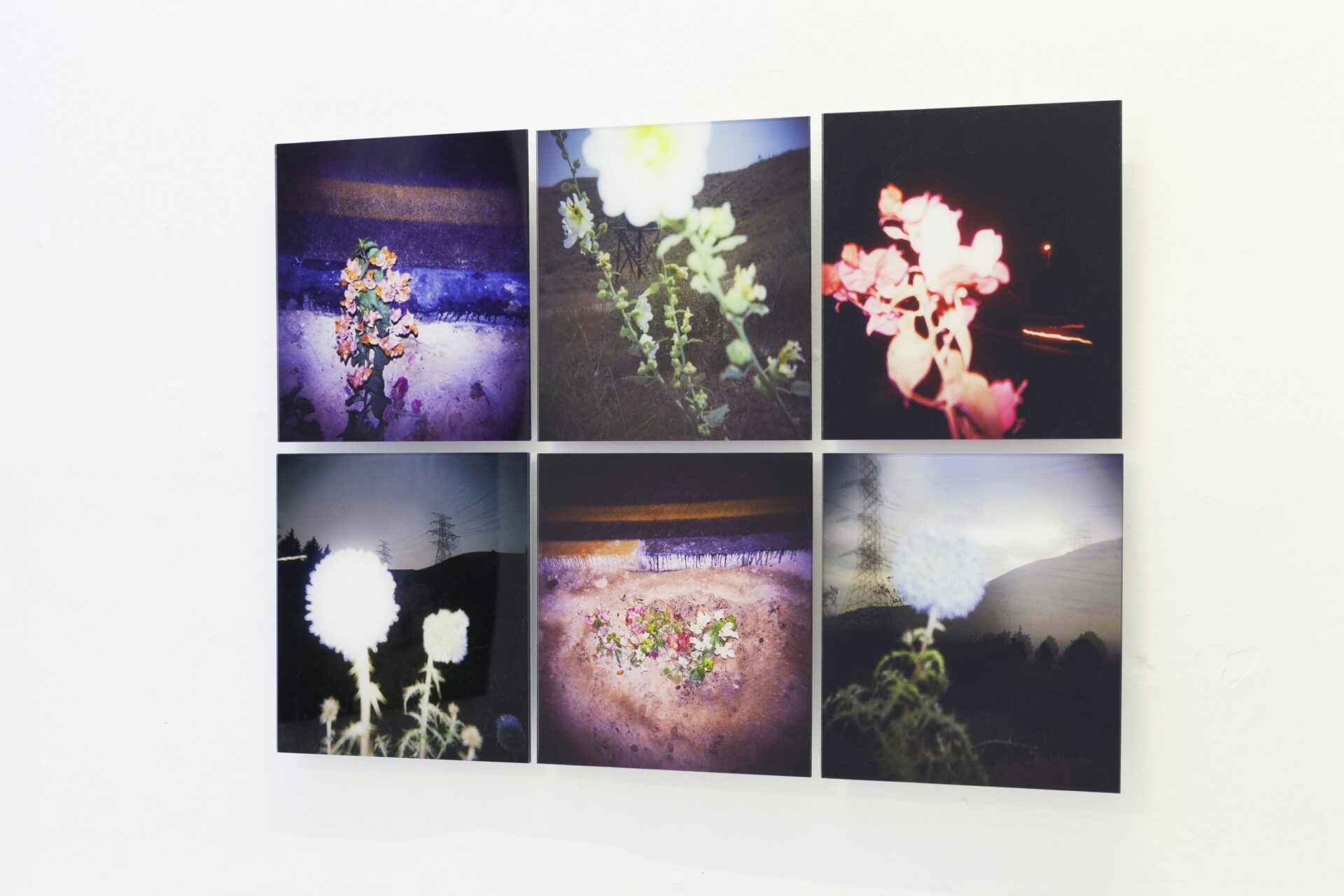
Chupan Mehraneh Atashi, installation shot at EKKM, photo: Paul Kuimet and EKKM
On the next wall, another series of pictures is displayed: Flowers (2010). These pictures bear similarities to the self-portraits, such as the prominent use of flash lighting on the central elements. However, in this series, the central subjects are wildflowers that have not been deliberately cultivated, but grow naturally, often in harsh conditions. When you observe these two series side by side, it is difficult not to discern a connection between them. Understanding the details of the artist’s imprisonment sheds light on the reasons behind the substitution of the self for the wildflowers.
During one of the interrogations at Evin Prison, the interrogators probed into the significance of the self and Atashi’s fascination with its representation. Atashi was told that they could no longer take self-portraits if they wished to continue their photography. Instead, the interrogators suggested, Atashi should try photographing flowers: ‘You can capture images of flowers with a striking backdrop or a dewdrop upon them, but not yourself.’ This unusual censorship method ultimately birthed the concept for Atashi’s next project.
Atashi explains that flowers carry symbolism within them, embodying ideas of morality and temporality, potentially growing isolated in desolate areas. In that sense, they could be compared to the vulnerable position of an artist in prison, isolated from others in a stark setting. Atashi conducted extensive research on the associations of flowers, particularly within various power structures. The imagery of a flower transformed into a metaphorical curtain designed to divert the viewer’s attention from violence, covering it in aesthetic beauty. Yet, beneath this facade of control lies a concealed message, a poignant reminder of the fragility faced by those who resist oppression.
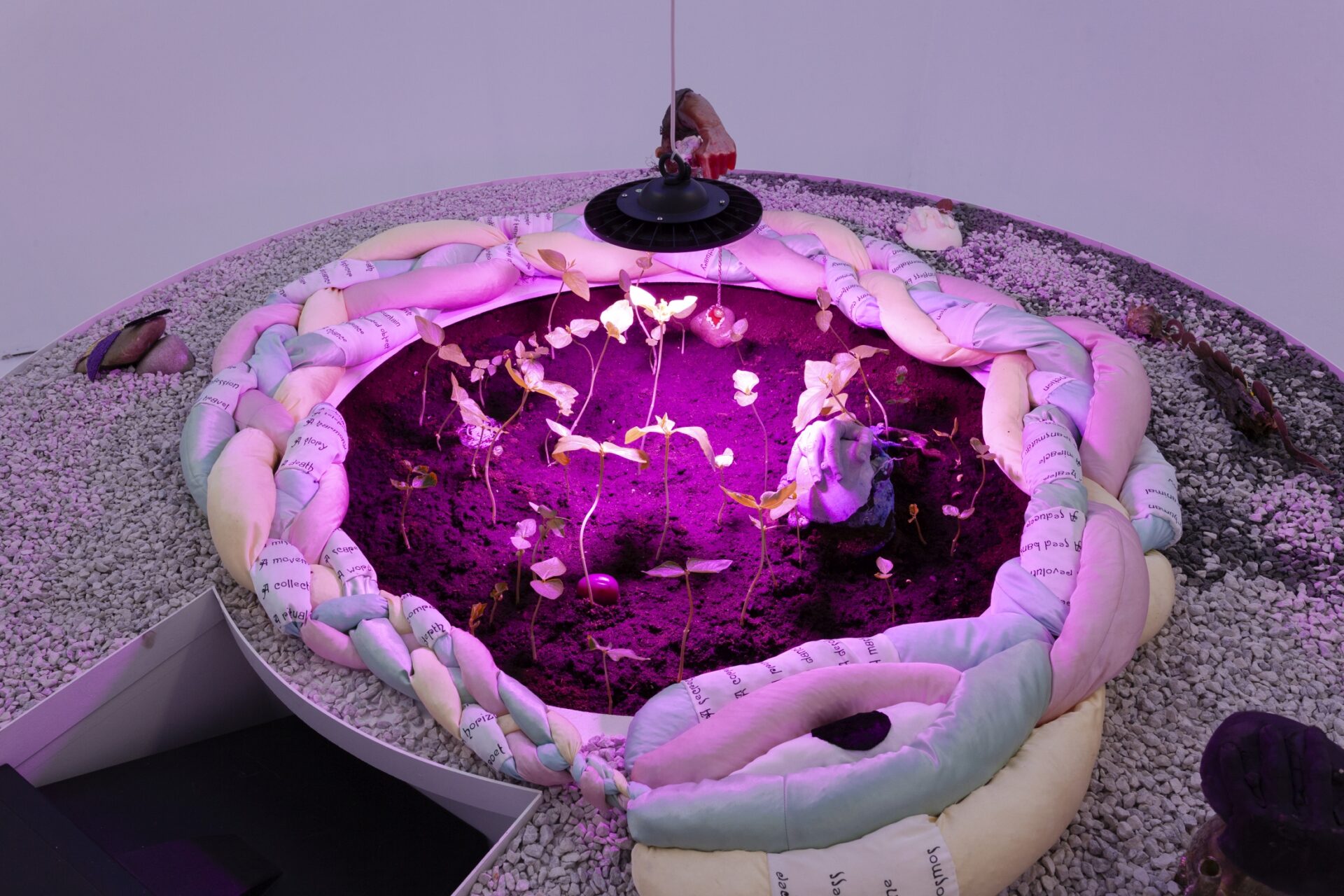
Chupan Mehraneh Atashi, installation shot at EKKM, photo: Paul Kuimet and EKKM
Atashi began capturing the essence of flowers that grow in certain locations, including those near Evin Prison, where the artist was held captive. Consequently, the portrayed self undergoes a transformation from one series to the next, shaped by the prevailing conditions. This continuous evolution is evident in their later works, which are also featured within the exhibition.
flowers carry symbolism within them, embodying ideas of morality and temporality, potentially growing isolated in desolate areas
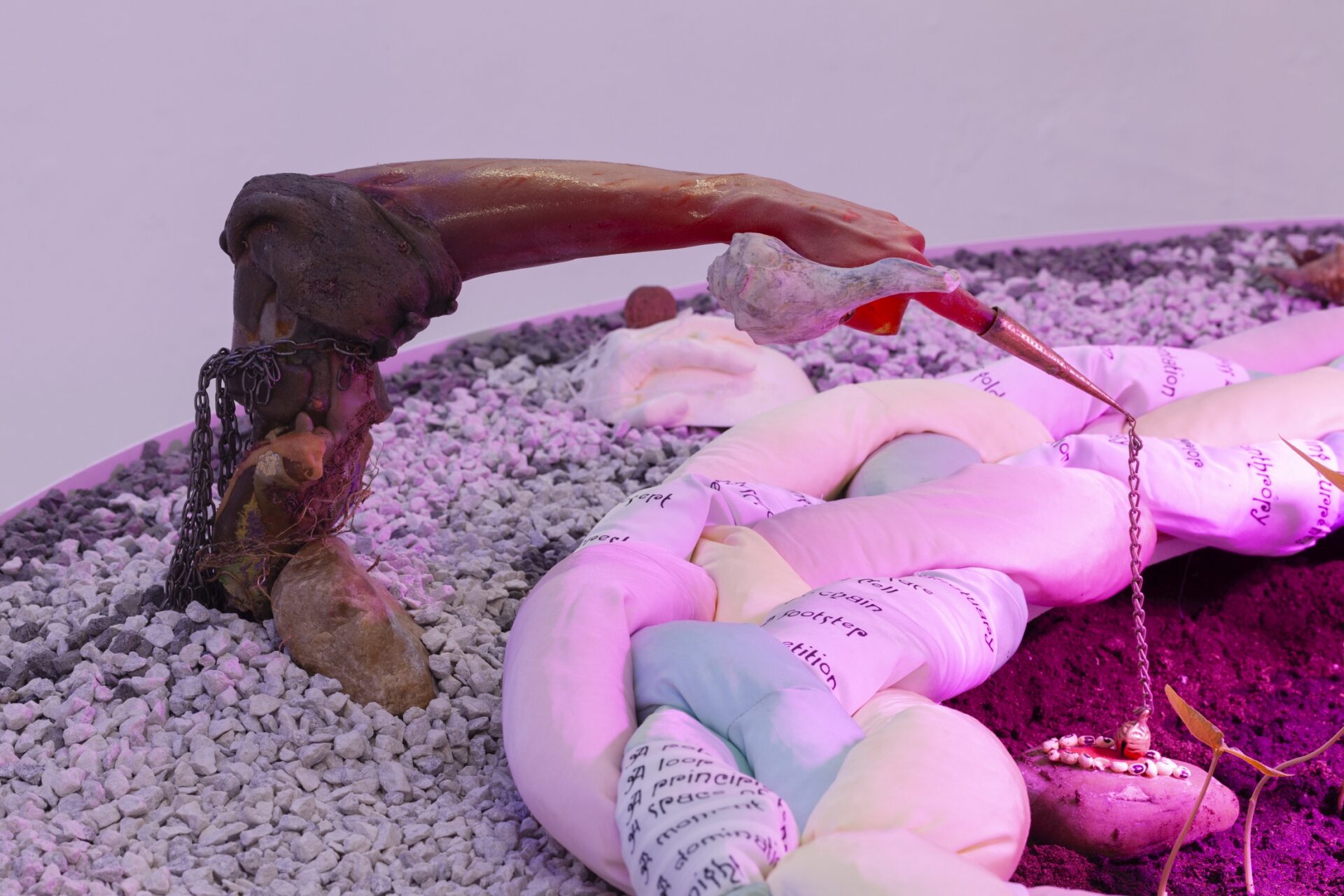
Chupan Mehraneh Atashi, installation shot at EKKM, photo: Paul Kuimet and EKKM
Directly in front of the pictures on the walls, stands a centerpiece installation. This white structure resembles tree rings, each layer preserving memories of its own. In the center a garden emerges, encircled by pebbles and a big ouroboros, the snake that eats its own tail, a symbol related to returning and incarnation. The installation incorporates elements from two previous photographic series, Memory Capsule and Seeding my Feet in the Chant of Bells, a video of the artist dancing as a teenager to a song sung by their mother and repetitive elements such as birds rendered in beadwork. There are also sculptural objects hidden in the installation, such as plaster-cast body parts and homely objects such as a teapot.
The seedbed that covers the structure, is bathed in the soft, radiant glow of purple light, carefully chosen to promote the growth of seeds. The sharp purple light, functioning as a form of nurturing care, gradually intensifies, casting a smooth transition in the space that mimics the eternal flow of a constant sunrise and sunset. This cyclical time envelopes the audience, allowing them to sense the evolving nuances during their visit and immersion in the space.
The installation as a whole represents the artist’s endeavor to create an ecosystem, a space prepared for growth. All these elements collectively create an atmosphere similar to that of a greenhouse, serving as a powerful metaphor for forced migration and the unyielding desire to perpetuate life. This intent care fosters a deep connection with the unstoppable power of growth, a proof to life’s triumphant resilience over death, a strength beyond human control, immune to any prohibition or restraint.
When I inquire about Atashi’s position within this ecosystem, they speak of inhabiting the middle, an intermediary state, or an ‘in-between’ within the larger context; living in the middle of the ouroborus. The entire ecosystem stands as a threshold, a fusion of life and death, an unending state of becoming. The work, in its entirety, manifests as a universe in the process of transformation.
Migrating seeds
Displacement is a crucial element in Atashi’s work. As Atashi’s initially defined themselves in opposition to the prevailing power structures of their direct context, these sources of power lost their former meanings and functions when Atashi left the country. Following their migration, they struggled with disorientation, leading to a tendency for working with fundamental elements like soil and fire, as evident in many of their works, such as Future of Future.[3] In their new space, Atashi employs various materials, including yeast, using fermentation as a method for preservation. In fact, after arriving in the Netherlands and attending the Rijksakademie, they embarked on creating a new ecosystem within their studio, serving as a bridge to the land and a deeper understanding of the surroundings. All these concerted efforts signify a transition to a new phase, marking the creation of an ecosystem situated in the realm of the in-between. This transitioning from home to an unfamiliar destination, compelled Atashi to reorient themself, to learn to navigate anew in their adopted environment.
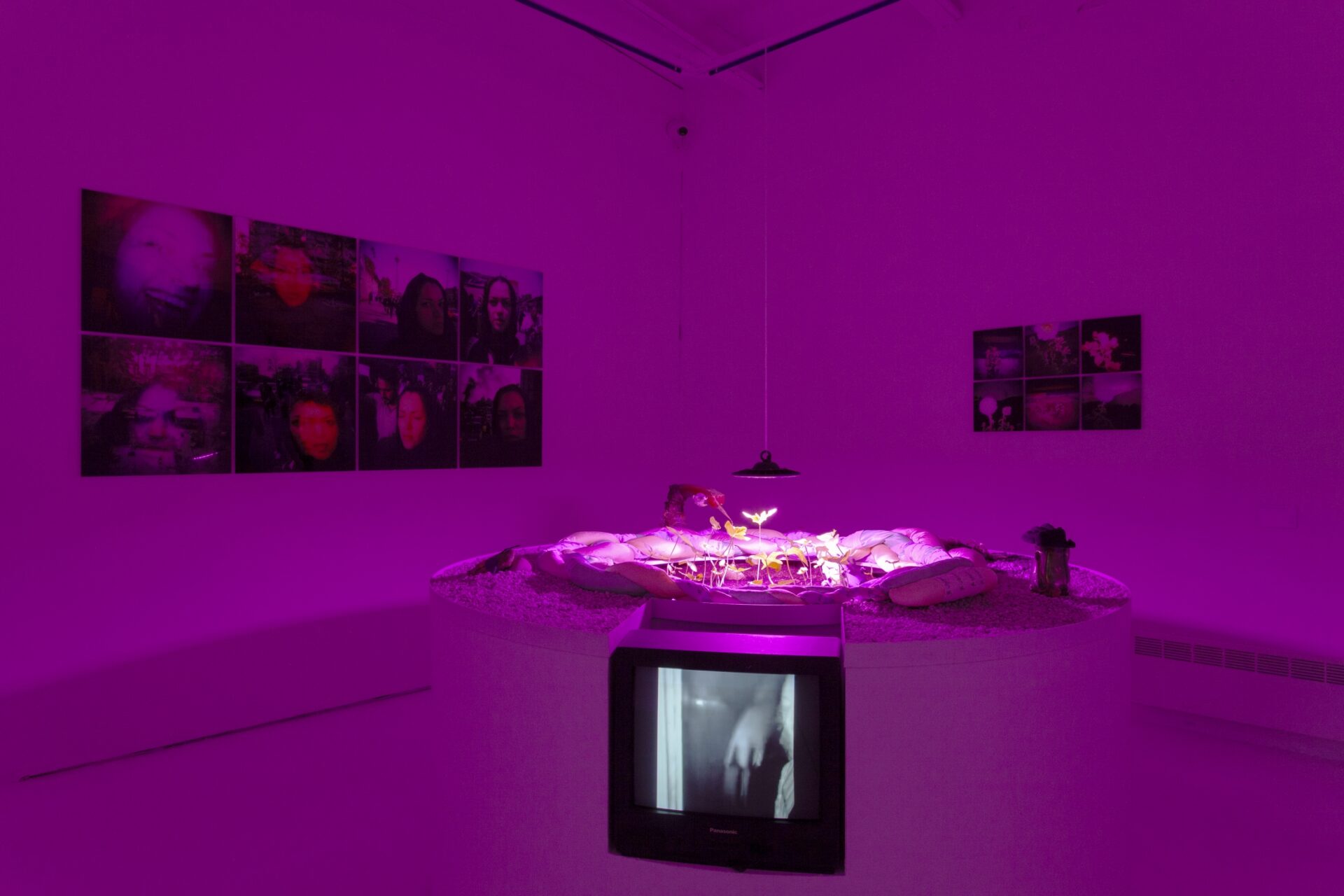
Chupan Mehraneh Atashi, installation shot at EKKM, photo: Paul Kuimet and EKKM
During this exploration, the body, once a symbol of resistance in earlier works and a mirror reflecting societal violence, undergoes a transformation. Yet, this transformation is not an end but a rebirth, a process of discovering another body and a self, aligned with the new place of residence. Significantly, this process is intertwined with Atashi’s personal life, marked by a gender transition to a non-binary identity, a transformation intricately woven into the fabric of the artist’s practice. Atashi delves deeper into their own identity within this new environment, striving to uncover new aspects that may have eluded their attention in the past. As a result, the body is positioned as a mobile ground for planting and harvesting, serving as a space for breaking dualities and discovering an in-between. This transformation is illustrated in how the artist’s body and self in the early works later evolve into flowers and seeds.
The entire ecosystem stands as a threshold, a fusion of life and death, an unending state of becoming
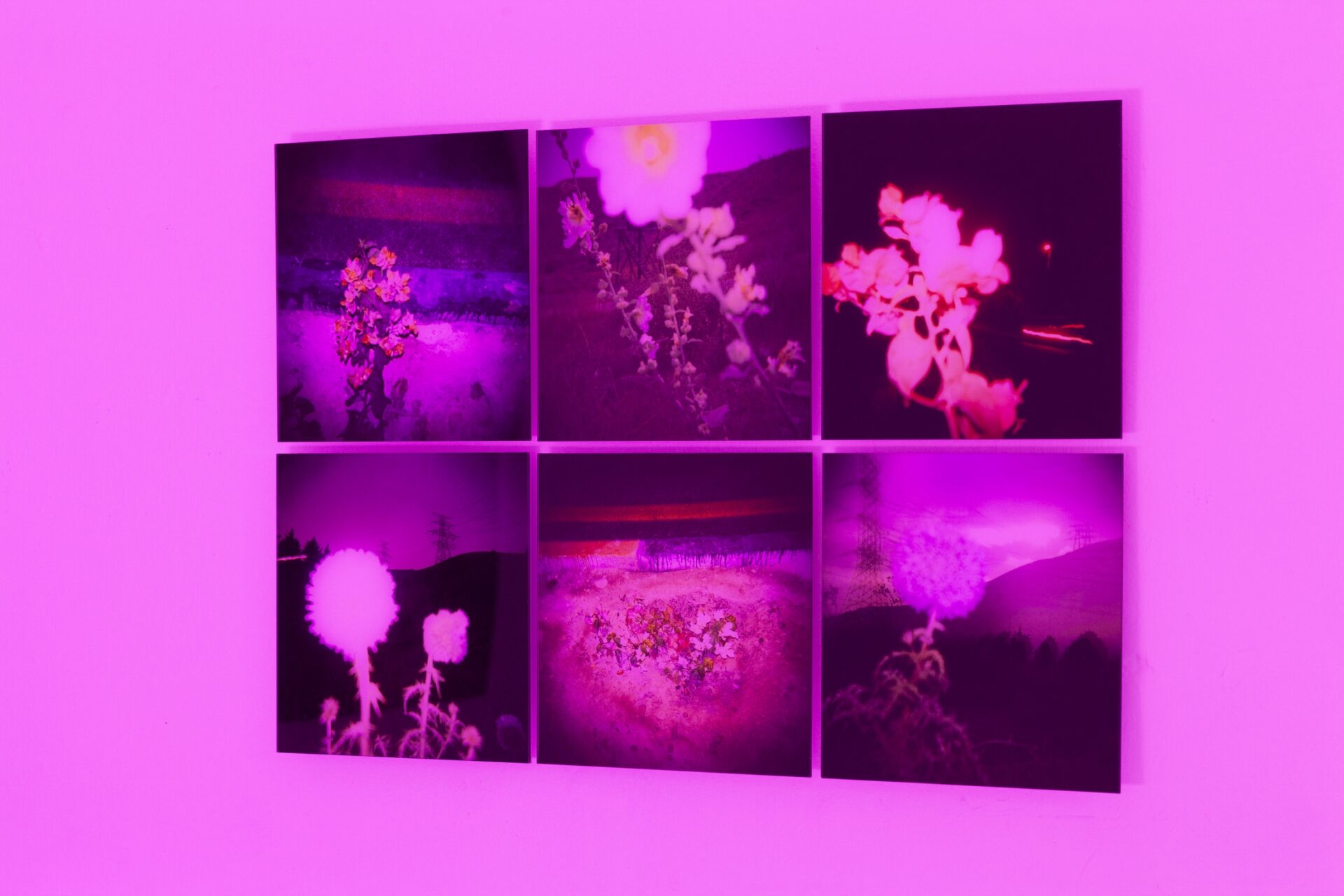
Chupan Mehraneh Atashi, installation shot at EKKM, photo: Paul Kuimet and EKKM
Whenever the artist travels for exhibitions, they carry with them all the seeds that their mother brought from their former home in 2017. The act of archiving, naming, categorizing, and carefully documenting these seeds, serves as a form of preparation for an unforeseen catastrophe. These seeds function as micro-memory capsules, encapsulating the artist’s story, a container of ancient memories from their ancestors that connect them to the generations of resistance against death.
The act of remembering, a daily practice, evolves into a wider perspective, an observation of the circle of life and death within a different context that allows the body to perceive new facets of the self. It adopts a mystical lens, minimizing the influence of power structures and adhering to the principles of suppressing those who seek liberation, even to the point of death. This inclination appears to be a reaction to the systematic suppression that Atashi experienced in Iran, particularly concerning their artistic agency.
Simultaneously, the persistent fear of forgetting and amnesia consistently underline the theme of preservation. The struggle revolves around combating amnesia, a contingent condition capable of eroding collective memory. However, the concept of preservation goes through a transformative shift: from maintaining the moments of resistance and bodily disobedience within oppressive spaces to preserving the seeds and memory capsules from the artist’s homeland. In fact, the earlier works were more closely tied to a local context, while the later works embrace a global perspective. Examining Atashi’s trajectory reveals a conceptual transformation, a shift from a more politically driven agency rooted in resistance, towards a more spiritual understanding of the self.
Their entire practice centers on the act of remembrance, transforming it into a spiritual ritual that encompasses the complete cycle of coming and returning. It’s akin to a vast circle that may appear as a mere line when viewed from a limited vantage point, but with a broader perspective, the entire circle comes into view. The effort to prevent forgetting serves to heighten awareness on a grander scale, emphasizing the resistance of life against the forces of death. This loop repeats with amnesia, as the artist mentioned. Yet, the most compelling aspect of this struggle for the artist is the creation of an ecosystem that exists somewhere in-between and evolves constantly and gradually.
[1] Referring to Atashi as ‘Her’ in the earlier works, including Tehran Self Portrait, is intentional and aligns with Atashi’s pronouns during that period (she/her). This choice is crucial given the significance of the female figure in that specific context.
[2] Atashi was arrested by Islamic Republic authorities before exhibiting the pictures of Tehran Self Portrait in an upcoming exhibition in 2010.
[3] 2020, The corner Gallery, Washington, DC
The group exhibition Laugh of Medusa is on view at EKKM from October 27th to December 17th, 2023. For more information, see the website of EKKM.
Katayoon Barzegar
is a visual artist


